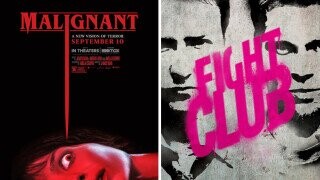How 'Where Is My Mind' Became Hollywood's Laziest Trope

Here's a weird trope no one talks about: an indie rock song about fish is now Hollywood's go-to shorthand for telling you that a character has issues telling the difference between what's real and what isn't -- especially if multiple personalities are involved. We're talking about "Where Is My Mind?" by the Pixies, first released in 1988 and first added to millions of mixtapes worldwide after it was used during Fight Club's explosive ending in 1999 (unless you happened to watch the Chinese version that replaced the explosions with "And then the cops arrested everyone").
Even though the song wasn't used during the moment when Edward Norton figures out that Brad Pitt only exists in his imagination, "Where Is My Mind?" still became synonymous with those kinds of plot twists. A famous example is the show Mr. Robot, which hit us with a piano cover right before Rami Malek's character finds out that the true Mr. Robot was in his heart all along (because the character of that name and him are the same person).
Don't Miss
Around the same time, the song was used in The Leftovers, whose protagonist also struggles with mental health issues and sees people who aren't there. This time they used the piano version and the original, so you know the guy is extra screwed up.
Some movies use it in a broader "what even is reality" sense, like Jared Leto's inexplicable Mr. Nobody (2009) and Zack Snyder's Sucker Punch (2011). On the latter, we hear another cover version as the protagonist is about to be lobotomized, and right before she enters her "Alice in Wonderland with strippers and also steampunk and dragons and sci-fi" fantasy world. Yes, Zack Snyder is 13.
Also, in 2009, Seth Rogen's Observe and Report used the song near the end, when a mall flasher exposes himself to the characters (and us). He may not have multiple personalities, but this version still qualifies as a Fight Club homage due to exposing the audience to male genitalia as the song plays -- just like Fight Club does via a split-second cut before the credits (you can stop looking frame by frame through the version we embedded above, it's not there).
In 2010 "Where Is My Mind" was used in It's Kind of a Funny Story (a rom-com set in a psychiatric ward) and four years later in Welcome to Me (about a lottery winner who goes off her meds and buys herself a talk show). We're getting away from the multiple personalities aspect here, so let's bring it back in a big way with the best/worst example yet: Malignant (2021). This one uses an instrumental version of the song as a recurrent theme throughout the movie as the protagonist gets strange visions of murders just as they happen. Gee, what could the plot twist here be?
Much later, it turns out that the killer and the protagonist share a body because he's her twin brother, who still exists as a malignant tumor on the back of her head. Okay, so not a whole lot of people probably guessed the exact specifics of that plot twist from just listening to the song, but it's still nuts that they would spoil the split personality aspect almost from the beginning through a music cue.
Also in 2021, the German film Die Heimsuchung used the song several times before revealing that the main character is a product of someone else's imagination. The irony here is that "Where Is My Mind?" isn't even about going insane or anything like that: it's about fish. Those lyrics about being in the Caribbean and floating in the water? Those aren't metaphors for anything. The song is about the time Pixies frontman Black Francis was snorkeling on a school trip in the Bahamas and saw some small fish chasing him. It would be more appropriate for Finding Nemo or a Spongebob episode or something.
Hollywood, it's time to retire this song and start overusing some other Pixies number like, say, the one that goes "Gigantic, gigantic, a big, big love." Wonder what that one's about.
Follow Maxwell Yezpitelok's heroic effort to read and comment on every '90s Superman comic at Superman86to99.tumblr.com. Ain't Pixies without Kim.
Top image: Warner Bros. Pictures, 20th Century Studios